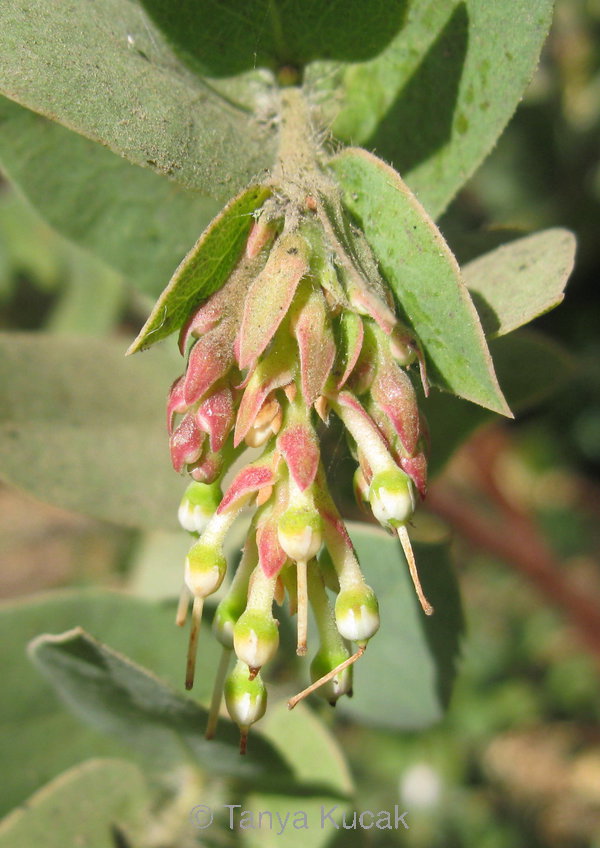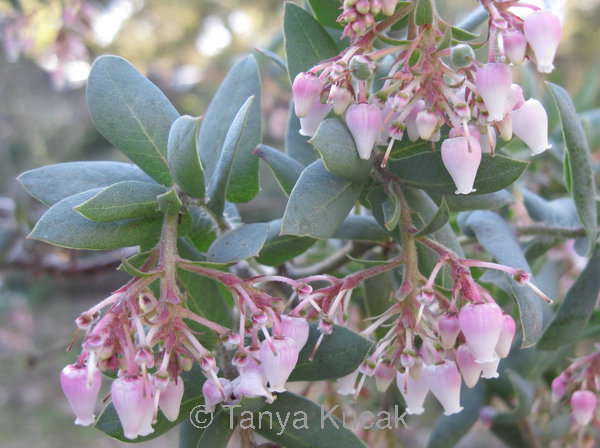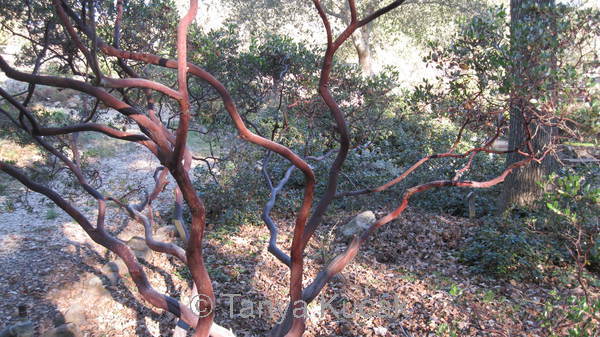
You don't need to prune manzanitas, according to Pete Veilleux, but if you do, you can reveal the spectacular mahogany bark and sculptural branch structure. If you plant a manzanita near a path or driveway, carefully prune each branch that grows toward the path. That way, you can create a clear view of the structure from the path, while maintaining the leafy cover and hummingbird-attracting flowers on the other sides of the shrub.
Veilleux, who runs East Bay Wilds Native Plant Nursery and Landscape Service, spends a lot of time observing native plants in the wild and uses that knowledge to inform his landscape work. At a talk sponsored by the Gardening with Natives group of the California Native Plant Society earlier this year, Veilleux shared photos of manzanitas in the wild and in gardens and talked about fifty or so favorites.
Manzanitas are the bones of the garden, according to Veilleux. They're long-lived, evergreen, beautiful, and drought-tolerant once established, and they require good drainage. Taking his cues from nature, where he typically finds several species growing together, he plants at least two to five species of manzanita in nearly every garden he installs. Most manzanitas prefer full sun, though a few can tolerate bright shade. He chooses manzanitas with contrasting leaf colors and in sizes ranging from groundcovers to tall shrubs.
Here are some cultivars and varieties Veilleux recommended.
Austin Griffiths manzanita gets 8-10 ft. high, is very easy to grow, and takes pruning and garden conditions well. Its best feature is large clusters of pepto-bismol pink flowers.
Franciscan manzanita, also very easy to grow, is a brilliant-green groundcover that grows very wide and flourishes in bright shade under pine trees, as long as no tree branches are touching it. Manzanitas do best under pines, not oaks, Veilleux said.
Bigberry manzanita is stunning with red red bark and whitish leaves. When young, the leaf colors change through the year, from yellow-green new growth to gray-blue. Veilleux found one in the wild that's 35 ft. high, but in gardens it stays around 10 ft. high.
Greensphere is the slowest growing manzanita in the world but needs more water than most manzanitas. Veilleux has kept one in a container for ten years. Unlike most manzanitas, which can grow in pots for 3-5 years but eventually need to go in the ground, it can stay potted. In the ground, it forms a 3-ft. sphere, reaching 4-5 ft. in time. Dense leaves clothe a gnarly trunk, and it flowers nicely.
John Dourley is one of the most useful manzanitas. It's a knee-high groundcover that spreads 10-15 ft. and eventually gets thigh-high. Bronzy new leaves make it stand out, and it can tolerate bright shade.
Sunset manzanita is another very easy, smallish, globe-shape plant that can get 4-5 ft. around but is easy to prune to 3-4 ft.
Most manzanitas prefer mineral mulch such as rocks or DG (decomposed granite). Veilleux showed a gopher-proof planting with manzanitas and DG between pavers.

Refugio manzanita, with auriculate leaves, is one of the fastest-growing varieties. It grows tall quickly, to 12-15 ft. You can tell a manzanita is “established” when it has put on a lot of growth in a certain amount of time, according to Veilleux, and you can let it go dry after that. For the most drama in a small yard, plant a groundcover, a short manzanita, and a tall manzanita.

Pajaro manzanita takes pruning well and stays about 6 ft. high. Prune regularly to stimulate growth and get more of its bronzy new leaves, which last a long time and can turn darker red and brighter orange. The fiery new leaves contrast well with older glaucous foliage.

Proper pruning reveals the sinuous branching structure and beautiful bark of larger manzanitas. When the shrub is relatively young, prune each branch on the path side of a shrub all the way to the trunk. If you prune only the leafy tips, the branch will die back to the trunk, weakening the plant.
© 2014 Tanya Kucak